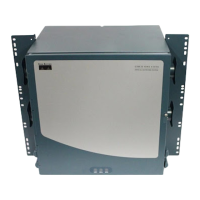20-7
Cisco ONS 15454 Procedure Guide, R5.0
March 2005
Chapter 20 DLPs A300 to A399
DLP-A313 Create a DCC Tunnel
DLP-A313 Create a DCC Tunnel
Note Cisco recommends a maximum of 84 DCC tunnel connections. Terminated Section DCCs used by the
ONS 15454 cannot be used as a DCC tunnel endpoint, and a Section DCC that is used as an DCC tunnel
endpoint cannot be terminated. All DCC tunnel connections are bidirectional.
Step 1 In network view, click the Provisioning > Overhead Circuits tabs.
Step 2 Click Create.
Step 3 In the Overhead Circuit Creation dialog box, complete the following in the Circuit Attributes area:
• Name—Type the tunnel name.
• Circuit Type—Choose one:
–
DCC Tunnel-D1-D3—Allows you to choose either the SDCC (D1-D3) or an LDCC (D4-D6,
D7-D9, or D10-D12) as the source or destination endpoints.
–
DCC Tunnel-D4-D12—Provisions the full LDCC as a tunnel.
Step 4 Click Next.
Step 5 In the Circuit Source area, complete the following:
• Node—Choose the source node.
• Slot—Choose the source slot.
• Port—If displayed, choose the source port.
• Channel—These options appear if you chose DCC Tunnel-D1-D3 as the tunnel type. Choose one of
the following:
–
DCC1 (D1-D3)—This is the SDCC.
–
DCC2 (D4-D6)—This is LDCC 1.
–
DCC3 (D7-D9)—This is LDCC 2.
–
DCC4 (D10-D12)—This is LDCC 3.
DCC options do not appear if they are used by the ONS 15454 (DCC1) or other tunnels.
Step 6 Click Next.
Step 7 In the Circuit Destination area, complete the following:
• Node—Choose the destination node.
Purpose This task creates a data communications channel (DCC) tunnel to transport
traffic from third-party SONET equipment across ONS 15454 networks.
Tunnels can be created on the Section DCC (SDCC) channel (D1-D3) (if
not used by the ONS 15454 as a terminated DCC), or any Line DCC
(LDCC) channel (D4-D6, D7-D9, or D10-D12).
Tools/Equipment OC-N cards must be installed
Prerequisite Procedures NTP-A35 Verify Node Turn-Up, page 5-2
Required/As Needed As needed
Onsite/Remote Onsite or remote
Security Level Provisioning or higher

